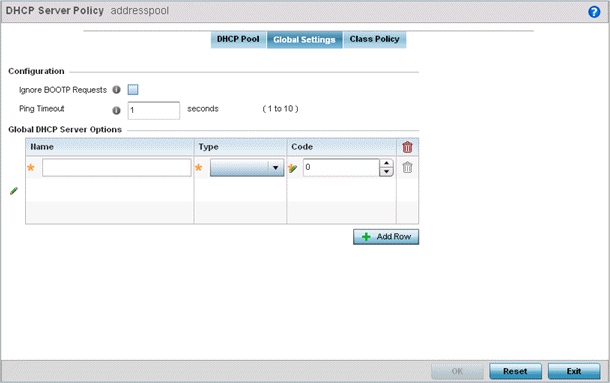Defining DHCP Server Global Settings
About this task
To define DHCP server global settings:
Procedure
-
Select DHCP Server Policy from
within the Services menu pane.
Add or Edit an existing policy.
-
Select the Global Settings tab.
 DHCP Server Policy - Add/Edit - Global Settings Tab
DHCP Server Policy - Add/Edit - Global Settings Tab
-
Set the following parameters within the Configuration
field:
Ignore BOOTP Requests Select the check box to ignore BOOTP requests. BOOTP (boot protocol) requests boot remote systems within the network. BOOTP messages are encapsulated inside UDP messages and forwarded. This feature is disabled by default, so unless selected, BOOTP requests are forwarded. Ping Timeout Set an interval (from 1 -10 seconds) for the DHCP server ping timeout. The timeout is the intermittent ping and discover interval to determine whether a client requested IP address is already used. -
Set the Activation Criteria for the
DHCP server policy:
Select the Criteria option to invoke a drop-down menu to determine when the DHCP daemon is invoked. Options include vrrp-master, cluster-master or rf-domain-manager.
A VRRP master responds to ARP requests, forwards packets with a destination link MAC layer address equal to the virtual router MAC layer address, rejects packets addressed to the IP associated with the virtual router, and accepts packets addressed to the IP associated with the virtual router. The solitary cluster master is the cluster member elected, using a priority assignment scheme, to provide management configuration and Smart RF data to other cluster members. Cluster requests go through the elected master before dissemination to other cluster members. The RF Domain manager is the elected member of the RF Domain capable of storing and provisioning configuration and firmware images for other members of the RF Domain.
-
Refer to the Global DHCP Server Options field.
-
Use the + Add Row button at the bottom of the
field to add a new global DHCP server option.
Select the radio button of an existing global DHCP server option and select the Delete icon to remove it from the list of those available.
-
Use the Type drop-down menu
to specify whether the DHCP option is being defined as a numerical IP
address, an ASCII string, or a hex string.
Highlight an entry from within the Global Options screen and click the Remove button to delete the name and value.
-
Use the + Add Row button at the bottom of the
field to add a new global DHCP server option.
-
Click OK to save the updates to the DHCP server global
settings.
Click Reset to revert the screen to its last saved configuration.


